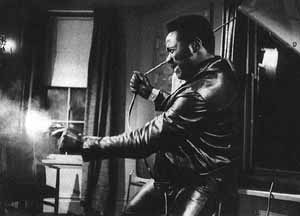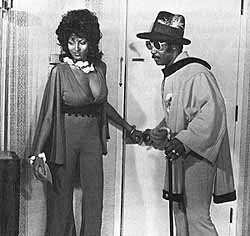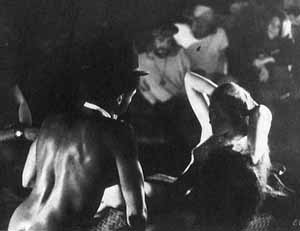|
It is important to note that blaxploitation arose at a critical juncture for the Hollywood film industry. From the late 1960s, mainstream Hollywood was in financial peril. The major studios were losing between $15 and $145 million leading many studios to face the distinct prospect of bankruptcy (Guerrero, 82-3). The success of Sweetback came as Hollywood fully realized the power of the black ticket buying public which accounted for more than 30 percent of the box office in major cities (Guerrero, 83). Hollywood quickly seized onto the seeming profitability of the Sweetback formula and spawned, what Guerrero calls, "the sons of Sweetback." For this discussion we should include the "daughters of Sweetback" as well.
1971's Shaft, directed by Gordon Parks, marked the beginning of Hollywood's attempt to cash in on Sweetback's success. Despite its black director and small budget, the film was in fact financed by MGM.

Richard Roundtree in Shaft.
Donald Bogle says, "This little picture, which its studio, MGM, thought might make a little money, instead made a mint - some $12 million within a year in North America alone - and single-handedly saved MGM from financial ruin" (238). The success of both Shaft and Sweetback was not lost on anyone. In the four years following Shaft, some 60 films that can be considered blaxploitation were made. Some of these films included Black Caesar (1973; starring Fred "The Hammer" Williamson), Hell Up in Harlem (1973), The Legend of Nigger Charlie (1972; a blaxploitation western), Boss Nigger (1974), Bucktown (1975), Super Fly (1972; infamous for its cocaine dealer named Priest and the title song Pusherman by Curtis Mayfield), Foxy Brown (1974; starring Tamara Dobsonís equally outrageous cohort, Pam Grier), Slaughter (1972; starring ex-Cleveland Browns running back and Ultimate Fighting Championship commentator, Jim Brown), Black Eliminator (1978; kung-fu blaxploitation), Black Mama, White Mama (1972; story by a rather misguided Jonathan Demme which he sold for $500), The Mack (1978), Coonskin (1975; an animated dig at the entire cinematic history of black representation), Scream, Blacula, Scream (1973; need any more be said), The Spook Who Sat by the Door (1973; not so much a blaxploitation film as a strongly political cinematic exploration of Black Power taken to its ultimate conclusion), The Black Gestapo (1975), and perhaps the best realized blaxploitation film, Willie Dynamite (1974).
This raises the question of what is a blaxploitation film? Despite popular opinion, there is no one pure example of blaxploitation. The range of stories are as varied as mainstream action films. However, action is an underlying element in all of them. Violence and guns appear in all blaxploitation films. What differentiates them from mainstream action films is, most obviously, the predominance of black characters in the narratives. Most blaxploitation films also use a "good/black versus white/evil allegory" (Guerrero 98) that often equates whiteness with criminality and deviant sexuality. This black versus white dichotomy was the defining element of Sweetback. Guerrero says, "The film tells the story of a "bad nigger" who challenges the oppressive white system and wins, thus articulating the main feature of the Blaxploitation formula" (86). Shaft's white evil comes in the form of the mafia who kidnap a black gangster's daughter. Both Cleopatra Jones films have white lesbian drug lords as their chief antagonists. Other elements of the blaxploitation formula include the glorification of drugs, especially cocaine, and living "the life," a term used to describe an urban existence which revolves around drugs, sex, pimps, gambling and guns.
Following Shaft's success, 1972 saw the proliferation of blaxploitation films, most notably the independently produced Super Fly, directed by Gordon Parks Jr.

Ron O'Neal in Superfly.
While a black production, Super Fly took living "the life" to the extreme by putting the drug dealer, Priest, as its center of focus. Priest's goal is to retire from "the life" by scoring a million dollars of cocaine and retiring on the profits. As has often been pointed out, Priest's retirement comes at the expense of his black community by flooding one million dollars of cocaine into the streets. In the process, Priest manages to outwit, or assault, all his white adversaries, including a corrupt police chief.
1972, 1973 and 1974 saw the bulk of blaxploitation films, which were being released every few weeks. The cover of the October 23, 1972 issue of Newsweek has the face of John Shaft with the headline, "Black Movies: Renaissance Or Ripoff?" The accompanying article states, "In an industry that has recently been producing little more than 200 films a year, fully one-fourth of those now in the planning stage are black" (Michener 77). However, this black movie boom was not the result of blacks gaining control in the white controlled film industry. As Donald Bogle points out:
What became most disturbing was that while these movies appeared to be black (in concept, in outlook, in feel) and while they were feverishly promoted and advertised as such, they actually were no such thing. Many of the new black-oriented films were written, directed, and produced by whites...Worse, many of the new movies were often shot on shoestring budgets, were badly directed, and were technically poor. The film industry hoped simply to make money by indeed exploiting an audience need. (241-42)
This fact was not lost on black audiences. Criticism of the films from both black and white sources sharply increased after Super Fly and continued until the end of the boom around 1975. As quickly as blaxploitation rose, production of black films fell off near the end of 1974. There were many reasons for the quick demise of the films. Ed Guerrero says:
Another factor that contributed directly to the demise of Blaxploitation was Hollywood's perception, near the end of 1973, that black audiences were tiring of the industry's cheap, endless reworkings of the crime-action-ghetto Blaxploitation formula...Accordingly, the film industry realized that it did not need an exclusively black vehicle to draw the large black audiences that had saved it from financial disaster. This important point was underscored when surveys showed that as much as 35 percent of the audience for the megahits The Godfather (1972) and The Exorcist (1973) was black. (105)
Blaxploitation did carry on with such reflexive films as Willie Dynamite (1974) and other more formula films through the 1970s. However, the boom was over in 1975. Cleopatra Jones and Cleopatra Jones and the Casino of Gold both come near the end of the boom, 1973 and 1975 respectively. The star of both Cleo films was the six foot two inch Tamara Dobson. Dobson and her cohort, Pam Grier, came to embody the female counterparts of Shaft and Sweetback.

Pam Grier in Coffy.
Darius James called Dobson the "Patron Saint of Harlem Drag Queens" (62) with her frequent costume changes in all their outrageous glory. What is evident in both Cleo films is that due to the heightened criticism of blaxploitation, the films' sex and glorification of drugs had been toned down. Both Cleo films lack the graphic sex scenes that marked movies such as Super Fly and Shaft. There is also none of the glorification of drugs as found in Super Fly. As a sort of counterpoint to Super Fly's montage of casual cocaine use, Cleopatra Jones shows a prolonged scene where Cleo and her boyfriend watch a man going through severe withdrawal symptoms.
Even though blaxploitation came to a sudden death in the mid-1970s, the films really never did commit their spirits to the great beyond. Its tropes carried on through the 1980s, occasionally being parodied (I'm Gonna Get You Sucka; 1988), and finally spawning another cycle, the hood movie, with such examples as New Jack City (1991) and Boyz N the Hood (1991). With a resurgence in popularity today, blaxploitation retrospectives spring up frequently and the recent film, Original Gangstas, resurrects the careers of blaxploitation stars Pam Grier, Fred "The Hammer" Williamson, Jim Brown and others.
page 2 of 5
 
You can move through the article by selecting "next page," or you can go to a specific section of the article by using the links below. In addition, you can check out our selection of links for blaxploitation Web sites.
Chris Norton received his B.A. in English and Film Studies from Oakland University, Rochester, Michigan and an M.A. from New York University in the Department of Cinema Studies. Chris welcomes comments or questions about his article. You can reach him at norteiga@aol.com.
|













